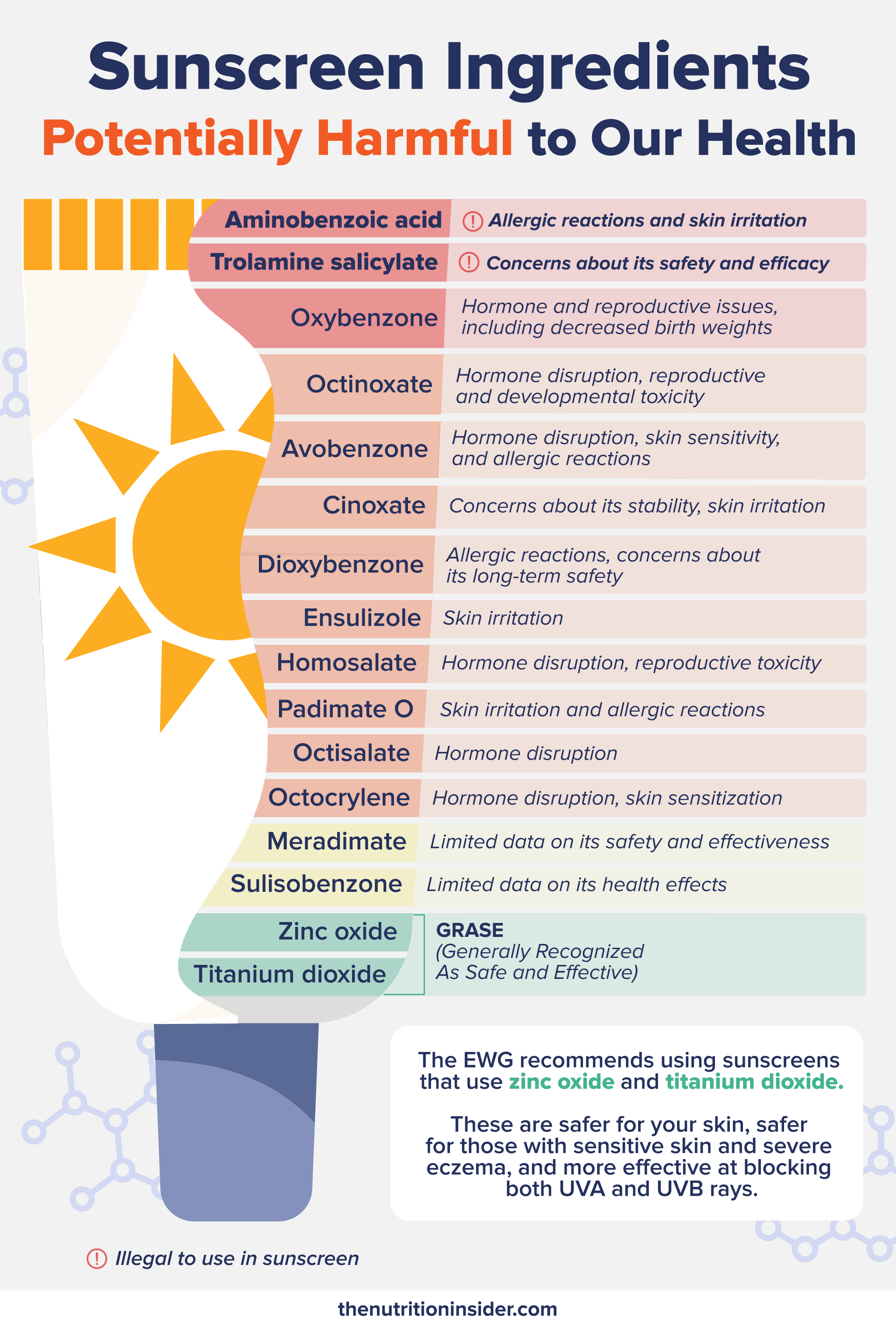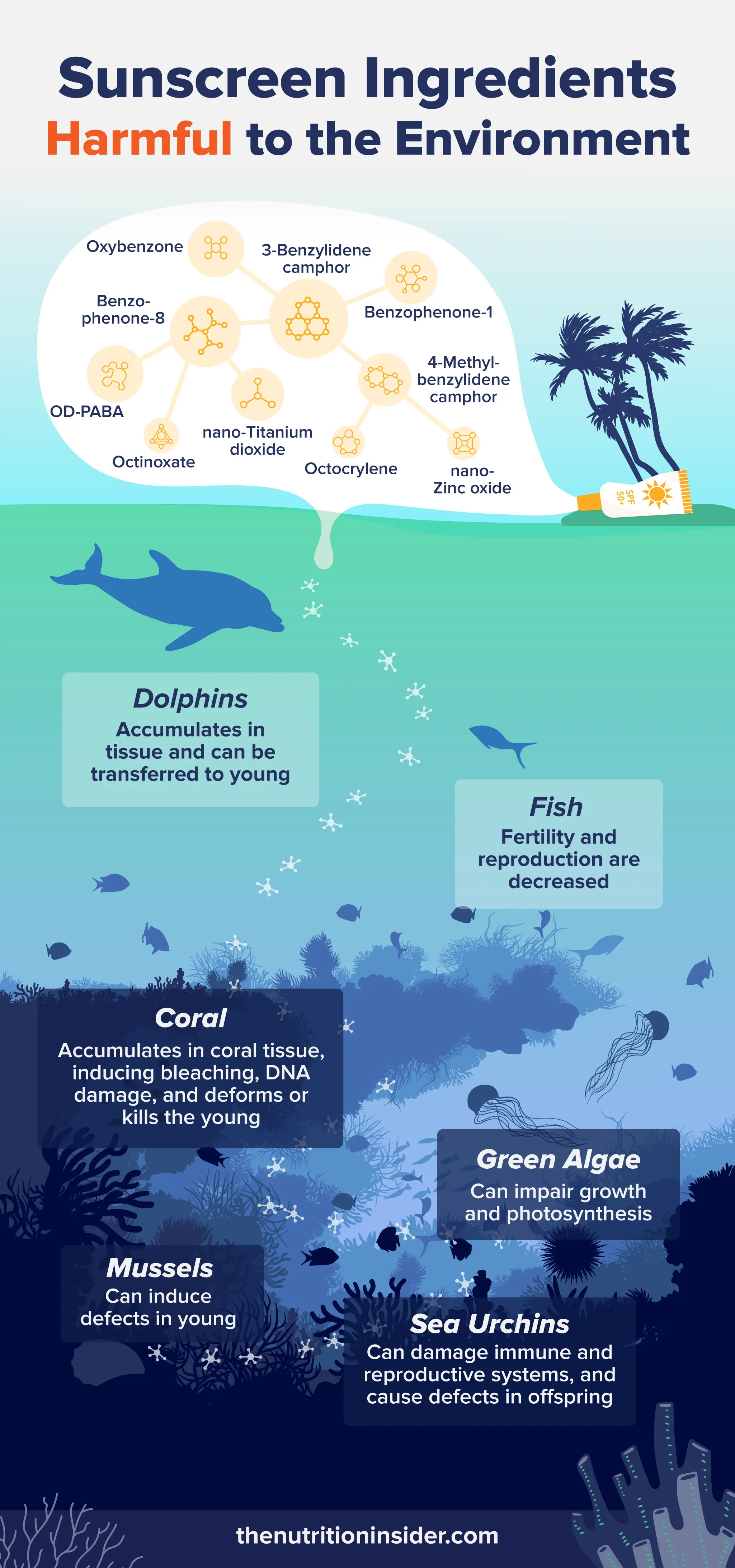Save $40 on your initial consult with a TNI Dietitian!
Talk to a real Dietitian for only $99: Schedule Now
This post contains links through which we may earn a small commission should you make a purchase from a brand. This in no way affects our ability to objectively critique the products and brands we review.
Evidence Based Research To fulfill our commitment to bringing our audience accurate and insightful content, our expert writers and medical reviewers rely on carefully curated research.
Read Our Editorial Policy
There is no question that wearing sun protection is vital when spending time outdoors.
However, one aspect that many may not consider is the impact sunscreen can have both on our bodies and on the environment.
In this article, we’ll break down which ingredients to avoid and which ones are perfectly safe to apply to your skin that also won’t harm the environment.
Wearing sunscreen is extremely important for preventing damage to our skin from harmful UV rays.
This is because UV radiation is classified as a “complete carcinogen” and repeated exposure can lead to premature aging (wrinkling), hyperpigmentation, immune suppression, eye damage, and is the leading cause of skin cancer.1,2
However, there are several ingredients used in sunscreens that have been called into question for their potential to harm our health.
Before we dive into the ingredients, let us insert a quick caveat: We’re not saying that wearing no sunscreen at all would be better than using sunscreen with these ingredients!

Tanning and sunburns are incredibly harmful to your health in the long term, and we have plenty of evidence to prove it. However, we cannot say the same for these ingredients—there is not enough data to prove anything conclusive.
So, this list should be regarded as a “thing to watch out for and use sparingly, if at all” instead of “avoid completely at the risk of damaging your skin.” Okay? Okay.
Per the Environmental Working Group (EWG), the US Federal Drug Administration (FDA) has only proved two of 16 sunscreen ingredients to be Generally Recognized As Safe and Effective (GRASE). These ingredients are zinc oxide and titanium dioxide.3
Here’s everything you need to know about the other 14 ingredients:
Aminobenzoic acid: The FDA has established that this ingredient is not GRASE and that it is illegal to use in sunscreen due to its potential to cause allergic reactions and skin irritation.3
Trolamine salicylate: The FDA has established that this ingredient is not GRASE and is illegal to use in sunscreen because of concerns about its safety and efficacy.3
Avobenzone: Avobenzone is a non-mineral UV filter that absorbs a broad range of UVA rays. It is systemically absorbed through the skin and can be detected in the blood weeks after application. There is evidence suggesting it may cause hormone disruption and potentially contribute to skin sensitivity and allergic reactions.4
Cinoxate: Cinoxate is a chemical sunscreen ingredient used for its UVB protection properties. It absorbs UVB radiation effectively but is less commonly used today due to concerns about its stability and potential for skin irritation.
Dioxybenzone: Dioxybenzone is a chemical sunscreen agent that protects against UVB rays. It has been associated with potential allergic reactions. There are concerns about its long-term safety, though comprehensive data on its systemic absorption is limited.
Ensulizole: Ensulizole is a chemical sunscreen ingredient that primarily provides UVB protection. It is often used in combination with other sunscreen agents to achieve broad-spectrum coverage. Ensulizole is considered relatively stable but may cause skin irritation in some individuals with sensitive skin.
Homosalate: Homosalate is a non-mineral UV filter that absorbs UVB rays. Due to safety concerns, it is not approved for use in the EU. It is systemically absorbed and can be detected in the blood weeks after application. There is evidence suggesting it may cause hormone disruption and contribute to potential reproductive toxicity.4
Meradimate: Meradimate is a chemical sunscreen agent that primarily absorbs UVA rays. It is less commonly used, and there is limited data on its safety and effectiveness. However, it is generally considered less irritating than other chemical filters.
Octinoxate: Octinoxate is a non-mineral UV filter that absorbs UVB rays. It is systemically absorbed and can be detected in the blood weeks after application. There is evidence suggesting it may cause hormone disruption and contribute to reproductive and developmental toxicity. Additionally, it is known to cause coral bleaching and is banned in some regions for environmental reasons.4,5
Octisalate: Octisalate is a non-mineral UV filter that absorbs UVB rays. It is systemically absorbed and can be detected in the blood weeks after application. Evidence suggests it may cause hormone disruption, though it is often used to stabilize other sunscreen ingredients and enhance their effectiveness.4
Octocrylene: Octocrylene is a non-mineral UV filter that provides protection against both UVA and UVB rays. Due to safety concerns, it is not approved for use in the EU at current levels. It is systemically absorbed and can be detected in the blood weeks after application, with evidence suggesting it may cause hormone disruption and contribute to skin sensitization.4
Oxybenzone: Oxybenzone has one of the highest potentials for harm among sunscreen ingredients. A systematic review of 23 studies concluded that exposure to this compound is correlated with hormone and reproductive issues, including decreased birth weights. It is a non-mineral UV filter that is systemically absorbed and can be detected in the blood weeks after application. Additionally, it has been shown to contribute to coral bleaching and harm to marine life and is banned in some regions for environmental reasons.5,6
Padimate O: Padimate O is a chemical sunscreen ingredient that primarily absorbs UVB rays. It is less commonly used today due to concerns about its potential to cause skin irritation and allergic reactions in those with sensitive skin. There is limited data available on its systemic absorption and long-term safety.
Sulisobenzone: Sulisobenzone is a chemical sunscreen agent that provides both UVA and UVB protection. Limited data exist on its systemic absorption and potential health effects, but it is generally considered less irritating than other chemical filters. It is often combined with other sunscreen agents to achieve broad-spectrum coverage.
Due to the lack of data showing conclusive harm, the FDA has not conclusively banned or acknowledged these ingredients as “not GRASE.”
As a result, you can still find many popular sunscreen products that use these ingredients, including the worrisome oxybenzone. Yikes!
The EWG recommends using physical sunscreen with mineral barriers that reflect—rather than absorb—UV rays. These are sunscreens that use zinc oxide and titanium dioxide. These are safer for your skin, safer for those with sensitive skin and severe eczema, and more effective at blocking both UVA and UVB rays.7
Want to know if your sunscreen is safe? Search for your sunscreen in the EWG sunscreen database here.8
Some sunscreen chemicals affect more than just your skin. They can also harm marine life, too.
But you’re just one person, right? How much could your sunscreen really impact the environment?
Well, according to researchers from the American Chemistry Society, up to 14,000 tons of sunscreen ends up in the ocean every year.9
For reference, that’s almost 11 million gallons, which equals 23 Olympic-sized swimming pools.
In the grand scheme of things, sure, 11 million gallons is a literal drop in the ocean.
However, pollutants from sunscreen often directly impact sensitive marine ecosystems, as they are typically concentrated in areas such as beaches, coral reefs, inlets, coves, rivers, and lakes. In other words, places that attract visitors and are home to diverse marine life and natural formations.

But what compounds typically impact marine life and how?
According to the National Oceanic and Atmospheric Administration (NOAA), the following compounds can negatively affect marine life: Oxybenzone, Benzophenone-1, Benzophenone-8, OD-PABA, 4-Methylbenzylidene camphor, 3-Benzylidene camphor, nano-Titanium dioxide, nano-Zinc oxide, Octinoxate, and Octocrylene.10
Here are some of the impacts these compounds can have on specific marine life:
So, you know which sunscreen ingredients to avoid. Now comes the hard part: finding sunscreen that is safe for you, your family, and the environment.
As mentioned previously, you can go to the EWG database and search for the sunscreens you have on hand. This way, you aren’t making unnecessary purchases if they are safe.
If you’re not satisfied with your sunscreen choices, we can help you quickly narrow down your search: opt for mineral sunscreens.
Mineral sunscreens, also known as physical sunscreen, use zinc oxide and titanium dioxide and are some of the safest and least harmful sunscreen ingredients.
They also tend to be more effective than chemical sunscreens since they physically reflect UV rays rather than absorb them.
These compounds are considered GRASE by the FDA since they are not readily absorbed by the skin. If they are absorbed, they don’t remain in the body for very long.
The primary concern with zinc oxide and titanium dioxide is inhalation when using aerosolized sunscreen or powders. So, it is advisable to use lotion or stick products instead.
Looking for the best non-toxic sunscreens? Head to our product round-up here:
Yes, certain types of sunscreen, particularly aerosolized sunscreens, can contribute to air pollution. When sprayed, these products can release small particles into the air that may be inhaled, potentially leading to respiratory issues. Additionally, the propellants used in these aerosols can contribute to air pollution and environmental harm.
Sunscreen pollution can manifest in several ways:
• Water Pollution: When people swim, sunscreen washes off their bodies and enters the water, affecting marine life.
• Bleached Coral Reefs: Chemicals like oxybenzone and octinoxate are known to cause coral bleaching and damage coral DNA, leading to the death of coral reefs.
• Affected Marine Life: Sunscreen compounds can accumulate in the tissues of marine organisms, causing reproductive and developmental harm.
Yes, there are several ways to reduce sunscreen pollution:
• Use Mineral Sunscreens: Opt for sunscreens that contain zinc oxide or titanium dioxide, which are less harmful to marine life.
• Wear Protective Clothing: Utilize UV-protective clothing, hats, and sunglasses to reduce the need for sunscreen.
• Choose Reef-Safe Sunscreens: Look for products labeled as reef-safe or biodegradable, which are formulated to minimize environmental impact.
• Proper Application: Apply sunscreen at least 15 minutes before swimming to allow it to absorb into your skin, reducing the amount that washes off.
Yes, you can buy plenty of coral reef-safe and non-toxic sunscreens. These sunscreens typically use mineral-based ingredients like zinc oxide and titanium dioxide, which are safer for your skin and the environment. Check the Environmental Working Group (EWG) database to find safe sunscreens for both you and the planet.